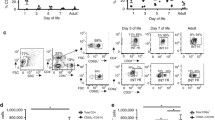Abstract
Our study aimed to study regulatory T cells (Tregs) and their expression of CD45RA, HLA-DR, and CD39 in preterm and full-term infants. In an observational study, we used a three-color flow cytometry for determination of Tregs and their expression of CD45RA, HLA-DR, and CD39 in preterm and full-term infants. The percentages of CD4+CD25+highFoxp3+, CD39+ Tregs, HLA-DR+ Tregs and the expression of Foxp3+ in CD4+CD25+highFoxp3 Tregs cells were significantly lower in neonates when compared to healthy adult controls. The levels of naïve resting Tregs (CD45RA+Tregs) were significantly higher in neonates than controls. The percentages of CD4+CD25+highFoxp3+Tregs, total CD4+CD25+ and CD4+CD25+high were significantly higher in preterm infants when compared to the full-term group. Moreover, CD45RA+Tregs were significantly higher in preterm than in term infants. We found significant inverse correlations between the gestational age and the levels of both Tregs (r = − 0.395, p = 0.017) and CD45RA+Tregs (r = − 0.422, p = 0.010). Relative to full-term, the frequencies, and phenotypes of Tregs were affected by prematurity. A larger longitudinal study with a sufficient number of newborns is needed to investigate the Treg pool of term and preterm infants thoroughly and to explore the association between the Treg pool and clinical variables.

Similar content being viewed by others
References
Baecher-Allan C, Wolf E, Hafler DA (2006) MHC class II expression identifies functionally distinct human regulatory T cells. J Immunol 176:4622–4631
Borsellino G, Kleinewietfeld M, Di Mitri D et al (2007) Expression of ectonucleotidase CD39 by Foxp3 + Treg cells: hydrolysis of extracellular ATP and immune suppression. Blood 110:1225–1232
Burt TD (2013) Fetal regulatory T cells and peripheral immune tolerance in utero: implications for development and disease. Am J Reprod Immunol 69:346–358
Crespo M, Martinez DG, Cerissi A et al (2012) Neonatal T-cell maturation and homing receptor responses to Toll-like receptor ligands differ from those of adult naive T cells: relationship to prematurity. Pediatr Res 71:136–143
Dirix V, Vermeulen F, Mascart F (2013) Maturation of CD4 + regulatory T lymphocytes and cytokine secretions in infants born prematurely. J Clin Immunol 33:1126–1133
Luciano AA, Yu H, Jackson LW et al (2011) Preterm labor and chorioamnionitis are associated with neonatal T cell activation. PLoS One 6:e16698
Luciano AA, Arbona-Ramirez IM, Ruiz R et al (2014) Alterations in regulatory T cell subpopulations seen in preterm infants. PLoS One 9:e95867
Ly NP, Ruiz-Perez B, McLoughlin RM et al (2009) Characterization of regulatory T cells in urban newborns. Clin Mol Allergy 7:8
Miyara M, Yoshioka Y, Kitoh A et al (2009) Functional delineation and differentiation dynamics of human CD4 + T cells expressing the FoxP3 transcription factor. Immunity 30:899–911
Ng WF, Duggan PJ, Ponchel F et al (2001) Human CD4(+)CD25(+) cells: a naturally occurring population of regulatory T cells. Blood 98:2736–2744
Rueda CM, Moreno-Fernandez ME, Jackson CM et al (2015a) Neonatal regulatory T cells have reduced capacity to suppress dendritic cell function. Eur J Immunol 45:2582–2592
Rueda CM, Wells CB, Gisslen T et al (2015b) Effect of chorioamnionitis on regulatory T cells in moderate/late preterm neonates. Hum Immunol 76:65–73
Saad K, Zahran AM, Elsayh KI et al (2018) Variation of regulatory T lymphocytes in the peripheral blood of children with allergic rhinitis. Arch Immunol Ther Exp 66:307–313
Sakaguchi S (2005) Naturally arising Foxp3-expressing CD25 + CD4 + regulatory T cells in immunological tolerance to self and non-self. Nat Immunol 6:345–352
Schlossberger V, Schober L, Rehnitz J et al (2013) The success of assisted reproduction technologies in relation to composition of the total regulatory T cell (Treg) pool and different Treg subsets. Hum Reprod 28:3062–3073
Shankaran S, Fanaroff AA, Wright LL et al (2002) Risk factors for early death among extremely low-birth-weight infants. Am J Obstet Gynecol 186:796–802
Stoll BJ, Hansen NI, Bell EF et al (2010) Neonatal outcomes of extremely preterm infants from the NICHD Neonatal Research Network. Pediatrics 126:443–456
Takahata Y, Nomura A, Takada H et al (2004) CD25 + CD4 + T cells in human cord blood: an immunoregulatory subset with naive phenotype and specific expression of forkhead box p3 (Foxp3) gene. Exp Hematol 32:622–629
Valmori D, Merlo A, Souleimanian NE et al (2005) A peripheral circulating compartment of natural naive CD4 Tregs. J Clin Invest 115:1953–1962
Funding
No funding was secured for this study. The authors have no financial relationships relevant to this article to disclose.
Author information
Authors and Affiliations
Corresponding author
Ethics declarations
Conflict of interest
All authors declare no potential conflicts of interest concerning the research, authorship, and/or publication of this article. All authors approved the final manuscript as submitted and agree to be accountable for all aspects of the work.
Ethical approval
The protocol of this study was under the regulations of the relevant clinical research ethics committee and with those of the code of ethics of the world medical association Declaration of Helsinki.
Informed consent
Written informed consents of caregivers of all children were taken according to the Ethical Committee of Faculty of Medicine, Assiut University, Egypt.
About this article
Cite this article
Zahran, A.M., Saad, K., Abdel-Raheem, Y.F. et al. Characterization of Regulatory T Cells in Preterm and Term Infants. Arch. Immunol. Ther. Exp. 67, 49–54 (2019). https://doi.org/10.1007/s00005-018-0530-x
Received:
Accepted:
Published:
Issue Date:
DOI: https://doi.org/10.1007/s00005-018-0530-x




